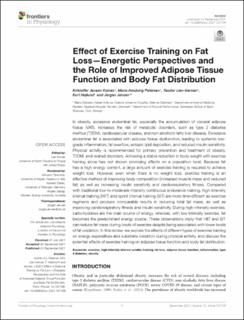| dc.contributor.author | Kolnes, Kristoffer Jensen | |
| dc.contributor.author | Petersen, Maria Houborg | |
| dc.contributor.author | Lien-Iversen, Teodor | |
| dc.contributor.author | Højlund, Kurt | |
| dc.contributor.author | Jensen, Jørgen | |
| dc.date.accessioned | 2022-03-21T20:23:13Z | |
| dc.date.available | 2022-03-21T20:23:13Z | |
| dc.date.created | 2021-10-26T08:58:13Z | |
| dc.date.issued | 2021 | |
| dc.identifier.citation | Frontiers in Physiology. 2021, 12, Artikkel 737709. | en_US |
| dc.identifier.issn | 1664-042X | |
| dc.identifier.uri | https://hdl.handle.net/11250/2986633 | |
| dc.description | This is an open-access article distributed under the terms of the Creative Commons Attribution License (CC BY). The use, distribution or reproduction in other forums is permitted, provided the original author(s) and the copyright owner(s) are credited and that the original publication in this journal is cited, in accordance with accepted academic practice. No use, distribution or reproduction is permitted which does not comply with these terms. | en_US |
| dc.description.abstract | In obesity, excessive abdominal fat, especially the accumulation of visceral adipose tissue (VAT), increases the risk of metabolic disorders, such as type 2 diabetes mellitus (T2DM), cardiovascular disease, and non-alcoholic fatty liver disease. Excessive abdominal fat is associated with adipose tissue dysfunction, leading to systemic low-grade inflammation, fat overflow, ectopic lipid deposition, and reduced insulin sensitivity. Physical activity is recommended for primary prevention and treatment of obesity, T2DM, and related disorders. Achieving a stable reduction in body weight with exercise training alone has not shown promising effects on a population level. Because fat has a high energy content, a large amount of exercise training is required to achieve weight loss. However, even when there is no weight loss, exercise training is an effective method of improving body composition (increased muscle mass and reduced fat) as well as increasing insulin sensitivity and cardiorespiratory fitness. Compared with traditional low-to-moderate-intensity continuous endurance training, high-intensity interval training (HIIT) and sprint interval training (SIT) are more time-efficient as exercise regimens and produce comparable results in reducing total fat mass, as well as improving cardiorespiratory fitness and insulin sensitivity. During high-intensity exercise, carbohydrates are the main source of energy, whereas, with low-intensity exercise, fat becomes the predominant energy source. These observations imply that HIIT and SIT can reduce fat mass during bouts of exercise despite being associated with lower levels of fat oxidation. In this review, we explore the effects of different types of exercise training on energy expenditure and substrate oxidation during physical activity, and discuss the potential effects of exercise training on adipose tissue function and body fat distribution. | en_US |
| dc.language.iso | eng | en_US |
| dc.subject | adipose tissue function | en_US |
| dc.subject | exercise | en_US |
| dc.subject | fat loss | en_US |
| dc.subject | high intensity interval aerobic training | en_US |
| dc.subject | inflammation | en_US |
| dc.subject | obesity | en_US |
| dc.subject | type 2 diabetes | en_US |
| dc.title | Effect of exercise training on fat loss—Energetic perspectives and the role of improved adipose tissue function and body fat distribution | en_US |
| dc.type | Peer reviewed | en_US |
| dc.type | Journal article | en_US |
| dc.description.version | publishedVersion | en_US |
| dc.rights.holder | © 2021 Kolnes, Petersen, Lien-Iversen, Højlund and Jensen | en_US |
| dc.source.pagenumber | 14 | en_US |
| dc.source.volume | 12 | en_US |
| dc.source.journal | Frontiers in Physiology | en_US |
| dc.identifier.doi | 10.3389/fphys.2021.737709 | |
| dc.identifier.cristin | 1948423 | |
| dc.description.localcode | Institutt for fysisk prestasjonsevne / Department of Physical Performance | en_US |
| dc.source.articlenumber | 737709 | en_US |
| cristin.ispublished | true | |
| cristin.fulltext | original | |
| cristin.qualitycode | 1 | |
